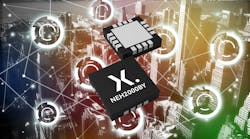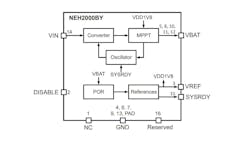Power-Management IC Makes Energy Harvesting Easy for IoT
A smart power-management IC recently rolled out by Nexperia can efficiently extract tiny amounts of power from energy sources such as light and vibration to run wireless sensors, wearables, and other IoT devices.
The NEH2000BY is designed to extract microwatts to milliwatts of power from solar and other sources of direct current (dc), including thermal and vibration. It can maximize energy harvested by intelligently adapting to the varying intensity of light or other energy sources. The extra power it wrings out opens the door for even more low-power off-mains devices to use energy harvesting, per Nexperia.
Energy harvesting is used to convert excess energy in the form of light, heat, vibration, or radio frequency into electricity that can be used to prolong the life of a battery or remove a device’s battery entirely.
Today, energy harvesting is limited, in that it can only supply sufficient power to IoT devices that expend mere milliwatts of power at a time, such as wireless sensors slapped on a factory floor or embedded in bridges and other infrastructure. Every drop of power counts when it comes to these battery-powered devices; thus, care must be taken to manage the current accurately and efficiently being recovered.
Power Extraction
At the heart of the NEH2000BY is the high-efficiency boost dc-dc converter. It’s intended to boost the input voltage of the extracted power to a higher output voltage that can replenish the device’s battery.
Energy that can be harvested by the IC—primarily from solar cells—ranges from 35 µW to 2 mW. But as long as the energy-harvesting cell matches the input voltage range of −0.3 to 5.3 V, it can also harvest vibrations and other forms of mechanical energy, such as human movement.
Housed in a 3- × 3-mm QFN package, the NEH2000BY is smart in the sense that it can adapt with the variable nature of ambient energy sources—for instance, changes in the luminosity of light (bright to dimly lit) and the fluctuating intensity of other energy sources. The total power that can be harvested depends on how fast the device can pinpoint the best power configuration given the present conditions.
To prevent power from being wasted, Nexperia said that it uses maximum power point tracking (MPPT) to convert harvested energy at up to 80% efficiency. The IC is not only accurate, but it can also check the input and adjust the load to make sure the energy source is operating in its peak output range for its present state. On top of that, the NEH2000BY is very fast, as it can adjust the load in less than a second.
Though unable to harvest from several sources at the same time, it’s possible to connect each one to a separate power-management IC or to multiplex different energy harvesters to a single Nexperia IC.
The energy-harvesting IC can be paired with Li-ion or other types of batteries with voltages in the range of 2.5 to 4.5 V to create a complete power supply for an IoT device. Supercapacitors are also supported.
All of these features make it possible to design IoT devices that can last for years without the battery being replaced, recycled, or disposed of, said Nexperia. The operating temperature ranges from –40 to +85°C.
Sustainable Power?
The other advantage of the energy-harvesting IC is that it limits bill-of-materials (BOM) costs. The IC is unique in that it only requires three capacitors per system—no inductors are needed.
As pointed out by Nexperia, many energy-harvesting systems use a dc-dc converter with a bulky inductor in the system. But the form factor of most IoT devices leaves no room for inductive switching converters.
The capacitive dc-dc converter inside the NEH2000BY can enable up to 90% BOM cost savings, according to the company.
The NEH2000BY also helps save valuable space on the circuit board. The power-management IC and all of the necessary components that surround it only require 12 mm² of real estate on the PCB, which is ideal for wearable devices with limited space to spare.
Energy harvesting also has a role to play in the sustainability of the IoT, which could expand to encompass a trillion or more devices in the future, per some of the most prominent names in the semiconductor industry. And many of those devices will be battery powered.
By removing single-use batteries that must be replaced or discarded once they run out of power, Nexperia said the new energy-harvesting IC can vastly reduce the amount of hazardous waste produced.


